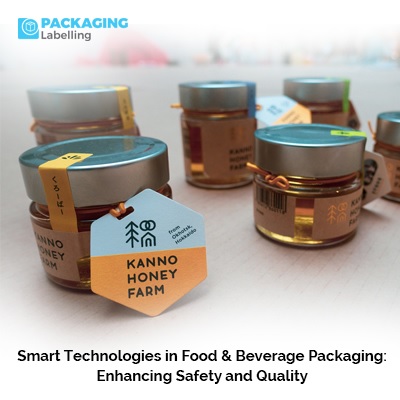Smart Technologies in Food & Beverage Packaging: Enhancing Safety and Quality

Introduction:
In the dynamic landscape of the food and beverage industry, ensuring the safety and quality of products is paramount. Smart technologies have emerged as a game-changer, revolutionizing the packaging processes and bringing a new level of sophistication to the sector. In this article, we will explore how smart technologies are enhancing safety and quality in food and beverage packaging, providing insights into the latest innovations that are reshaping the industry.
IoT-enabled Packaging:
One of the key advancements in smart packaging is the integration of Internet of Things (IoT) technologies. IoT-enabled packaging allows for real-time monitoring and tracking of various parameters throughout the supply chain. Smart sensors embedded in the packaging can provide data on temperature, humidity, and even the freshness of the contents. This real-time monitoring ensures that the products are stored and transported under optimal conditions, minimizing the risk of spoilage or contamination.
RFID Technology:
Radio-Frequency Identification (RFID) is another smart technology making waves in the food and beverage packaging sector. RFID tags can be attached to packaging, enabling efficient inventory management and traceability. This technology facilitates quick identification and tracking of products, aiding in the swift removal of any contaminated or compromised items from the supply chain. RFID also enhances transparency, allowing consumers to access detailed information about the product's journey from production to their hands.
| Read More: What are the key packaging solutions that cater to B2B food and beverage clients? |
Blockchain for Transparency:
Blockchain technology has gained significant attention for its potential to enhance transparency and traceability in the food and beverage industry. By implementing blockchain in packaging, every stage of the supply chain can be recorded and securely stored in an unalterable ledger. This not only ensures the authenticity of the product but also helps in identifying and addressing any issues swiftly. Consumers can scan QR codes on packaging to access a comprehensive history of the product, including its origin, processing, and distribution.
| Also Read: The Impact of Smart Packaging Technologies on Food & Beverage Industry Growth |
Active and Intelligent Packaging:
Smart packaging goes beyond passive containment; it actively interacts with the environment to maintain or enhance the quality of the enclosed food or beverage. Active packaging includes features like oxygen scavengers and moisture absorbers that extend the shelf life of products by preventing oxidation and spoilage. Intelligent packaging, on the other hand, incorporates indicators such as time-temperature indicators or freshness sensors that provide real-time information on the condition of the contents.
Nanotechnology for Enhanced Safety:
Nanotechnology is playing a pivotal role in improving the safety of food and beverage packaging. Nano-based materials can be incorporated into packaging to create barriers against contaminants and pathogens. These materials can also enhance the mechanical properties of the packaging, making it more robust and resistant to damage during transportation. Nanotechnology acts as an extra layer of defense, safeguarding products from external threats and ensuring the integrity of the packaging.
Augmented Reality (AR) for Consumer Engagement:
Beyond the realm of physical packaging, smart technologies are also influencing the way consumers interact with products. Augmented Reality (AR) is being used to create immersive and informative experiences for consumers. By scanning product packaging with a mobile device, consumers can access virtual information overlays, such as nutritional details, recipe suggestions, or even interactive games. This not only engages consumers but also provides them with valuable insights into the product.
Machine Learning in Quality Control:
Machine Learning (ML) algorithms are becoming increasingly integral in quality control processes within the food and beverage packaging industry. These algorithms can analyze vast amounts of data to identify patterns and anomalies, enabling early detection of potential quality issues. By automating quality control processes, machine learning contributes to faster and more accurate assessments, reducing the risk of defective products reaching consumers.
Biodegradable and Sustainable Materials:
Smart technologies are not only focused on enhancing functionality but also on addressing the growing concern of environmental sustainability. Packaging materials made from biodegradable and compostable substances are gaining traction. Smart packaging solutions are incorporating these eco-friendly materials, ensuring that the benefits of technological advancements do not come at the cost of environmental degradation.
Regulatory Compliance and Food Safety:
Compliance with stringent regulatory standards is a critical aspect of the food and beverage industry. Smart technologies aid in meeting these standards by providing accurate and verifiable data throughout the supply chain. Automated monitoring and recording of critical parameters help manufacturers demonstrate adherence to safety regulations, reducing the risk of recalls and ensuring consum er trust in the brand.
Challenges and Future Outlook:
While smart technologies have significantly improved safety and quality in food and beverage packaging, challenges remain. The cost of implementing these technologies, interoperability issues, and the need for industry-wide standards are some hurdles that the sector must overcome. Looking ahead, continued advancements in smart packaging are expected, with a focus on affordability, scalability, and increased collaboration among stakeholders.
Conclusion:
Smart technologies are ushering in a new era of innovation in food and beverage packaging, bolstering safety and quality across the entire supply chain. From real-time monitoring with IoT to the transparency offered by blockchain, each technology plays a crucial role in ensuring that consumers receive products that meet the highest standards. As the industry continues to evolve, the integration of smart technologies is likely to become more widespread, reshaping not only how products are packaged but also how consumers interact with and trust the brands they choose.









